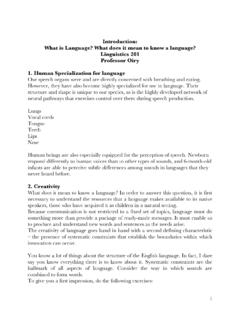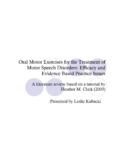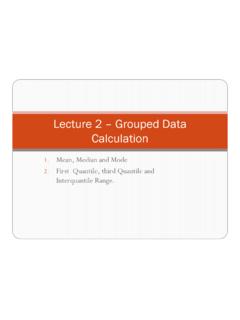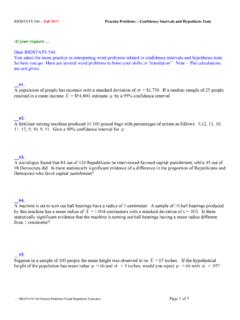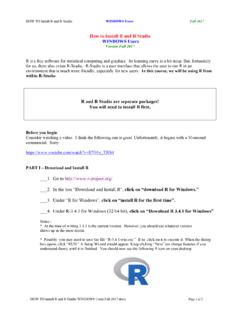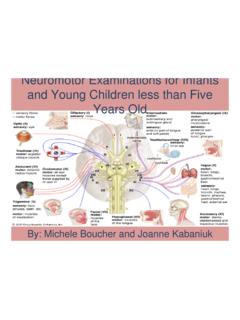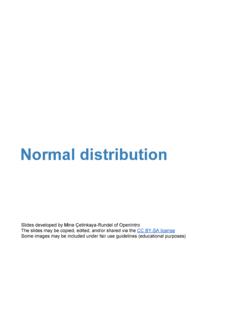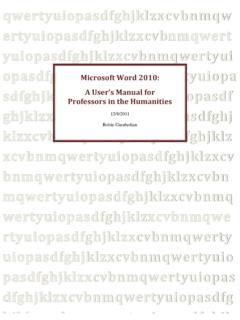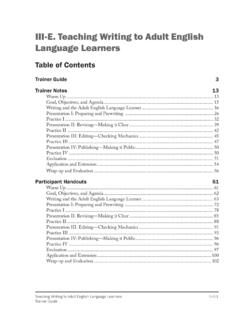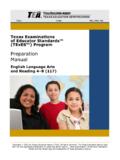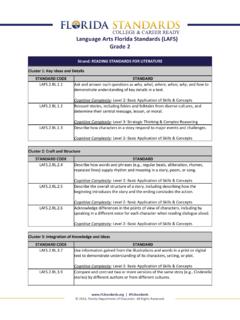Transcription of Treiman, R., Clifton, C., Jr, Meyer, A. S., & Wurm, L. H ...
1 Treiman, R., Clifton, C., Jr, Meyer, A. S., & Wurm, L. H. (2003). language comprehension and production. Comprehensive Handbook of Psychology, Volume 4: Experimental Psychology. New York: John Wiley & Sons, Inc. Pages 527-548. Copyright John Wiley & Sons. Psycholinguistics: language comprehension and production Rebecca Treiman Wayne State University Charles Clifton, Jr. University of Massachusetts Antje S. Meyer University of Birmingham Lee H. Wurm Wayne State University Acknowledgments: Preparation of this chapter was supported by NSF Grant SBR-9807736 to and NIH Grant HD18708 to the University of Massachusetts.
2 To appear in Healy & Proctor (Eds.), Comprehensive handbook of psychology, Vol. 4: Experimental Psychology. New York: Wiley. Treiman et al., Psycholinguistics, 2 Introduction language comprehension Spoken word recognition Printed word recognition The mental lexicon Comprehension of sentences and discourse Phenomena common to reading and listening comprehension Phenomena specific to the comprehension of spoken language Phenomena specific to the comprehension of written language language production Access to single words in spoken language production Generation of sentences in spoken language production Written
3 language production Conclusions INTRODUCTION Psychologists have long been interested in language , but psycholinguistics as a field of study did not emerge until the 1960s. It was motivated by Chomsky s work in linguistics, and by his claim that the special properties of language require special mechanisms to handle it ( , Chomsky, 1959). The special feature of language on which Chomsky focused was its productivity. Possessed with a grammar, or syntax, humans can produce and understand novel sentences that carry novel messages. We do this in a way that is exquisitely sensitive to the structure of the language .
4 For example, we interpret The umpire helped the child to third base Treiman et al., Psycholinguistics, 3 and The umpire helped the child on third base as conveying distinct messages, although the sentences differ in just one small word. We know that He showed her baby the pictures and He showed her the baby pictures describe quite different events, even though the difference in word order is slight. We can even make some sense of Colorless green ideas sleep furiously (Chomsky, 1971), which is semantically anomalous but syntactically well formed.
5 The same kinds of abilities are found at other levels of language . We combine morphemes (units of meaning) in systematic ways, and so understand Lewis Carroll s (1871/1977) slithy toves to refer to more than one tove that has the characteristics of slithiness. And we can combine phonemes (units of sound) according to the patterns of our language , accepting slithy but not tlithy as a potential English word. Early psycholinguists described our comprehension and production of language in terms of the rules that were postulated by linguists (Fodor, Bever, & Garrett, 1974).
6 The connections between psychology and linguistics were particularly close in the area of syntax, with psycholinguists testing the psychological reality of various proposed linguistic rules. As the field of psycholinguistics developed, it became clear that theories of sentence comprehension and production cannot be based in any simple way on linguistic theories; psycholinguistic theories must consider the properties of the human mind as well as the structure of the language . Psycholinguistics has thus become its own area of inquiry, informed by but not totally dependent on linguistics.
7 Although Chomsky and the early psycholinguists focused on the creative side of language , language also has its rote side. For example, we store a great deal of information about the properties of words in our mental lexicon, and we retrieve this information when we Treiman et al., Psycholinguistics, 4 understand or produce language . On some views, different kinds of mechanisms are responsible for the creative and the habitual aspects of language . For example, we may use morpheme-based rules to decompose a complex word like rewritable the first few times we encounter it, but after several exposures we may begin to store and access the word as a unit (Caramazza, Laudanna, & Romani, 1988; Schreuder & Baayen, 1995).
8 Dual-route views of this kind have been proposed in several areas of psycholinguistics. According to such models, frequency of exposure determines our ability to recall stored instances but not our ability to apply rules. Another idea is that a single set of mechanisms can handle both the creative side and the rote side of language . Connectionist theories (see Rumelhart & McClelland, 1986) take this view. Such theories claim, for instance, that readers use the same system of links between spelling units and sound units to generate the pronunciations of novel written words like tove and to access the pronunciations of familiar words, be they words that follow typical spelling-to-sound correspondences, like stove, or words that are exceptions to these patterns, like love ( , Plaut, McClelland, Seidenberg, & Patterson, 1996; Seidenberg & McClelland, 1989).
9 In this view, similarity and frequency both play important roles in processing, with novel items being processed based on their similarity to known ones. The patterns are statistical and probabilistic rather than all-or-none. Early psycholinguists, following Chomsky, tended to see language as an autonomous system, insulated from other cognitive systems. In this modular view (see Fodor, 1983), the initial stages of word and sentence comprehension are not influenced by higher levels of knowledge. Information about context and about real-world constraints comes into play only after the first steps of linguistic processing have taken place, giving such models a serial quality.
10 On an interactive view, in contrast, knowledge about linguistic context and about the world Treiman et al., Psycholinguistics, 5 plays an immediate role in the comprehension of words and sentences. In this view, many types of information are used in parallel, with the different sources of information working co-operatively or competitively to yield an interpretation. Such ideas are often expressed in connectionist terms. Modular and interactive views may also be distinguished in discussions of language production, where one issue is whether there is a syntactic component that operates independently of conceptual and phonological factors.
